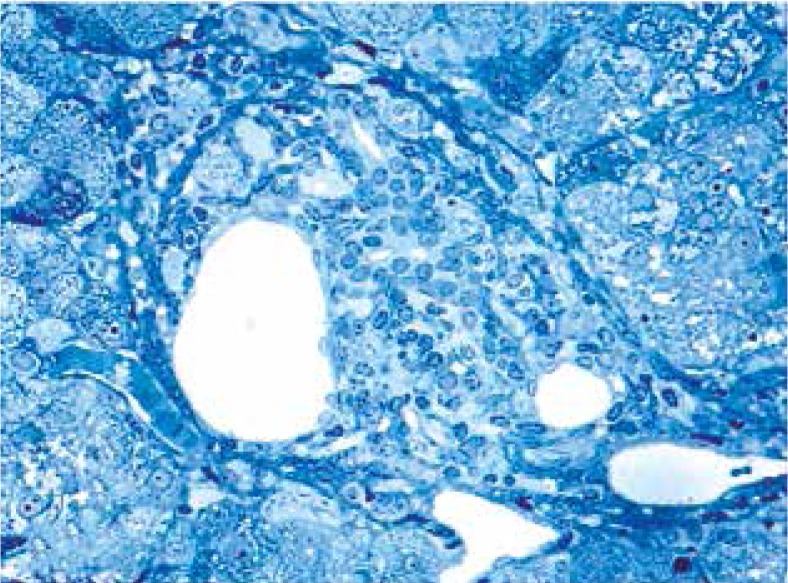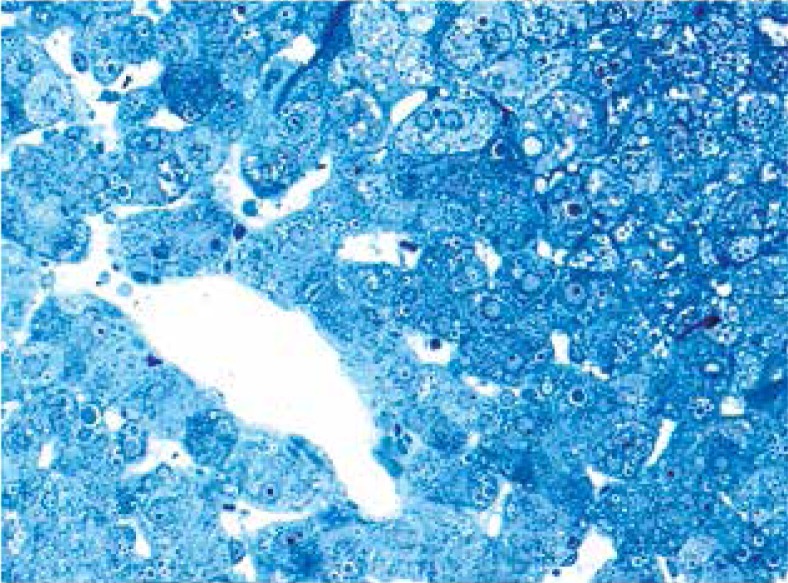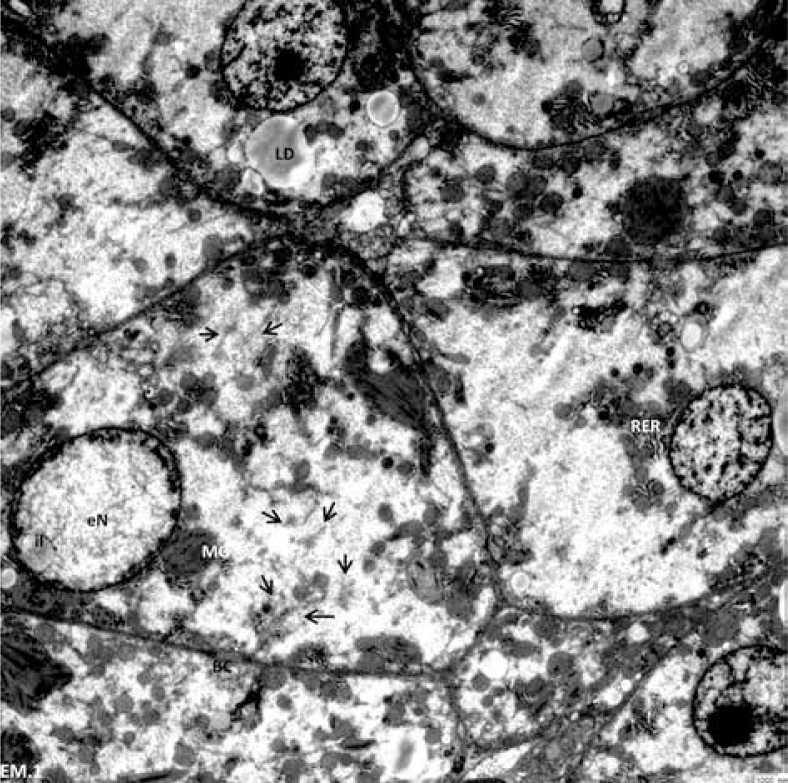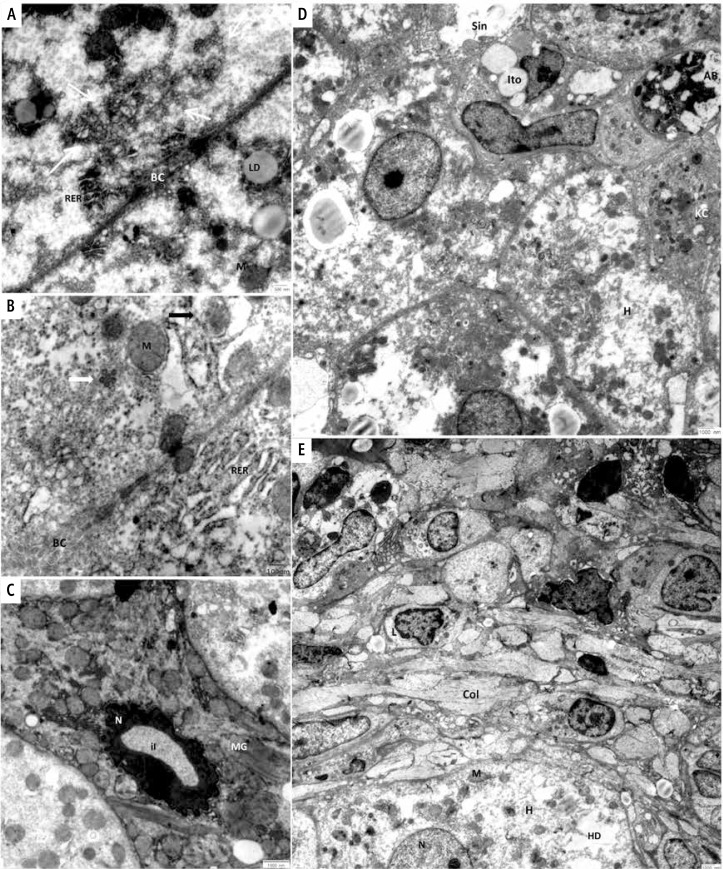Abstract
Although chronic hepatitis C virus (HCV) infection affect 185 million people world-wide, pathomechanism of liver damage is still unclear. Electron microscopy can reveal liver injury in very early stage and help understanding the mechanisms that is crucial in the pathogenesis of chronic hepatitis C. We present the morphological changes in the liver of HCV infected 24-year-old female patient, using light and transmission electron microscopy. Examination by TEM revealed wide range of specific subcellular abnormalities in hepatocellular ultrastructure. The most common observed changes were ring-shaped nuclei with intranuclear inclusion, megamitochondria, and “membranous web” structures – the hallmark of RNA-viruses infection.
Keywords: megamitochondria, HCV infection, hydropic degeneration, acidophilic degeneration, membranous web
Introduction
Hepatitis C virus (HCV) is a highly mutable RNA virus, a member of the Flaviviridae family. The seven major HCV genotypes (GTs) have been identified. Their prevalence rates differ by geographical region, but the most common is GT1 subtype β [1]. The acute infection is infrequently diagnosed because the clinical course is often silent. Therefore, in most cases, HCV leads to chronic infection, which is a global health issue, affecting more than 185 million people worldwide [2]. Patients with chronic hepatitis C (CHC) are known to be in risk of developing liver complications including cirrhosis, liver failure, and hepatocellular carcinoma. It is estimated that more than 350,000 people die from HCV-related liver disease every year [3].
Material and methods
We report a case of 24-year-old Caucasian female with CHC. In October 2012, she was hospitalized for caesarian delivery and anti-HCV antibody was detected in routine tests. Then in May 2013, she was admitted to Clinic of Infectious Diseases to perform medical assessment and extensive diagnostic tests for hepatitis C infection. No abnormalities in physical examination was found. Laboratory tests revealed slightly elevated alanine aminotransferase activity – 72 IU/l (reference range, 5-50) with normal aspartate aminotransferase activity – 43 IU/l (reference range, 5-50). An abdominal ultrasonography was normal. The presence of HCV RNA (genotype 1b) was detected in serum. A percutaneous liver biopsy was performed, showing preserved cytoarchitectonics of the organ; viral hepatitis of minor grade (A-6) with periportal fibrosis (F-2) (HAI Ishak). Disseminated ballooning degeneration of hepatocytes was present too. From January to December 2015, she was treated with a 48-week course of pegylated interferon α-2a (PegIFNα-2a) with ribavirin, and achieved sustain viral response after 24 weeks (SVR 24). During routine diagnostic liver biopsy, a small piece of tissue (1 mm3) was taken for ultrastructural studies. It was fixed by immersion in 3% glutaraldehyde, post-fixed in 2% osmium tetroxide, dehydrated, and embedded in EPON 812 according to a standard protocol. Semithin Epon sections (0.5-1 µm) were stained with a basic toluidine blue and studied with a Nikon ECLIPSE 80i light microscope. Ultrathin sections (50-60 nm) were double contrasted with uranyl acetate and lead citrate, and examined with TESLA BS500 transmission electron microscope. Electron micrographs were taken with a slow scan camera (Variospeed 1K-SSCCD camera, TRS, Germany).
Light microscopic findings
Light microscopic observations of semithin sections showed the liver with intact architecture of lobules (Fig. 1). Portal tracts were expanded by a modest infiltration of mononuclear inflammatory cells with only a local interface hepatitis (Fig. 2). Mild portal fibrosis does not exceeded the area of portal tracts (Figs. 1 and 2). The most signs of pathological alterations of the hepatic tissue were present in the periportal region of parenchyma (hepatocytes in zone 1) (Figs. 1–3). Many of the cells in this field were pale-staining. They had altered, reticulated, cleared, rarefied cytoplasm. These cells revealed a mild hydropic degeneration. In the close proximity to the portal tract, there were visible cells with “empty” nuclei (feature of karyolysis). In addition to pale-staining cells, a single or clusters of shrunken hepatocytes with deeply condensed cytoplasm and pyknotic, deeply basophilic nucleus were noted (Fig. 1A). Features of parenchyma regeneration were observed. It was manifested by mitosis (Fig. 1B) and irregularly thickened liver cell plates in the periportal region.
Fig. 1.
Light microscopic observations of semithin epon sections (toluidine blue stain; original magnification 200×). Mild hydropic degeneration of hepatocytes of periportal zone. The hepatocytes have pale-staining, rare cytoplasm. Portal tract (PT), “empty” nucleus (black arrow), lipid droplet (white arrow). A) Two basic types of hepatocellular changes: hydropic degeneration (•) and acidophilic degeneration (♦). B) Hepatocyte mitosis (white bold arrow)
Fig. 2.
Portal inflammation of mild grade – inflammatory cells limited mainly to portal tracts
Fig. 3.
Perivenular zone of liver lobule
Electron microscopic findings
Electron microscopic observations of the same area as illustrated in (Fig. 1) confirmed the light microscope findings. Hepatocytes visible in the Figure 4 exhibited “cytoplasmic dissociation”, a change characterized by swelling of cells with cytoplasmic rarefaction, coarse clumping of cytoplasmic organelles, and eventually lysis of nuclei. They showed a significant reduction in the number of organelles and an increase in empty areas of the cytoplasm, where only the glycogen granules were visible. In one of the cells, there was a visible “empty” nucleus (karyolysis) with intranuclear inclusion. The studies revealed numerous mitochondrial abnormalities, such as: heterogeneity of shapes and size, reduction of the amount of mitochondria, and formation of megamitochondria with linear crystalline inclusions within the matrix. The measurement of the cross sectional area of mitochondria directly from electron micrographs showed a significant increase in mitochondrial sizes (to about 5 µm with maximum to about 10 µm) (Fig. 4). In addition to mitochondrial alterations, we observed a large numbers of small cytoplasmic vesicles in almost all hepatocytes (Fig. 4 and 5A). Virus-induced vesicles were generally smooth-walled and arranged linearly along the filament/membrane forming multiple clusters evident within the cytoplasm, varying in location from perinuclear to peripheral. The rough endoplasmic reticulum was significantly reduced to a few short channels with a slightly enlarged luminal space. Electron micrograph (Fig. 5B) revealed a few virus-like particles lying free in the cytoplasm and cytoplasmic vesicles containing virus-like particles. Generally, cytoplasmic organelles were accumulating around the nucleus or in the area of the bile canaliculi. Electron microscopy studies also revealed hepatocytes undergoing acidophilic degeneration (Fig. 5C). The formation of acidophil bodies, visible in sinusoid of Fig. 5D, was a later stage of acidophilic degeneration. Electron micrograph Fig. 5E showed the fragment of portal tract and interface between portal tract and parenchyma. A mild portal inflammation and mild fibrosis confined to portal areas were visible.
Fig. 4.
Ultrastructure of hepatocytes of periportal and transition zone. MG – megamitochondria (giant mitochondria) containing crystalline inclusions; membranous web (black arrows); N – nucleus; eN – “empty” nucleus (ringshaped nucleus); iI – intranuclear inclusion; RER – rough endoplasmic reticulum; LD – lipid droplet; BC – bile canaliculus; bar = 1000 nm
Fig. 5.
A) Interface between the two adjacent hepatocytes: membranous web (white arrows), M – mitochondria, RER – rough endoplasmic reticulum, BC – bile canaliculus, LD – lipid droplet; bar = 500 nm EM. B) A few virus-like particles (white arrows) lying free in the cytoplasm and cytoplasmic vesicle containing virus-like particles associated with amorphous material (black arrows); bar = 100 nm. C) Hepatocyte undergoing apoptosis (shrinkage necrosis, acidophilic degeneration): MG – megamitochondria; N – pyknotic nucleus, iI – Intranuclear inclusion; bar = 1000 nm. D) Hepatocytes of perivenular zone. Acidophilic body extruded from the liver cell plate into a sinusoid: Sin – sinusoid, AB – acidophilic body, Ito – Ito cell, KC – Kupffer cell, H – hepatocyte; bar = 1000 nm. E) The fragment of portal tract and interface between portal tract and parenchyma: H – hepatocyte, Col – the bundles of collagen fibers, L – lymphocyte, N – nucleus, M – mitochondria, HD – hydropic degeneration; bar = 1000 nm
Discussion
Chronic viral hepatitis is a syndrome of persisting (more than 6 months) viral infection in the liver that is characterized morphologically by a combination of inflammatory cell infiltration, hepatocellular damage, and cell death, atrophy, regeneration and fibrosis. These components may have a different relative proportion and distribution [4, 5]. Light microscopic studies of liver tissue obtained by needle biopsy from a 24-year-old women with CHC revealed two basic types of hepatocellular changes. The first one was a mild hydropic degeneration of liver cell with cytoplasmic rarefaction, coarse clumping of cytoplasmic organelles, and eventually lysis of nuclei. The second one was acidophilic degeneration characterized by shrinkage of cytoplasm and pyknosis of nucleus (Fig. 1 and 1A). The observed changes were consistent with the literature data [4, 5]. Hydropic degeneration is a common feature in viral hepatitis [4, 5]. The liver cells become pale-staining as a result of intracellular edema [4]. Their cytoplasm is rarefied, pale-cloudy, vacuolated or empty, with remnants of granular or stratified cytoplasmic material, which is faintly eosinophilic (in H&E stain), usually packed around the nucleus or along the cell membrane [6]. Due to the combination of swelling and rounding of the affected cells, the term ‘balloning degeneration’ (currently preferred term ‘hydropic swelling’) is sometimes applied. The nuclei of affected cells are also enlarged and pale-staining with loose structure, ending up in karyolysis [4, 6].
Electron microscopy studies confirmed the histological observations, and revealed a wide range of highly specific subcellular abnormalities in hepatocellular ultrastructure, which reflect the cytopathic effects of infection. The ultrastructure of few hepatocytes, which had features of mild hydropic degeneration with cytoplasmic dissociation has been shown (Fig. 4). These cells were characterized by a reduction and clumping of cytoplasmic organelles (they form clusters) and loosening of the cytoplasmic matrix. There were suspicions that cytoplasmic dissociation might be a structural manifestation of microtubule cytoskeleton disruption. In one of the cells, there was a visible characteristic empty nucleus with loss of chromatin from central region of nucleus and condensed chromatin near the nuclear membrane in the form of very thin ring. Current literature data suggest that ring-like transformation of the nuclei is characteristic for viral infections, including also HCV infection. In our study, these nuclei were frequently observed, especially in hepatocytes zone 1. In addition, characteristic, frequently repeating intranuclear inclusion were observed (Fig. 4). Falcón et al. [7] examined liver biopsies from patients with CHC and proved that intranuclear inclusion formation is one of the most common cytopathic effects of virus infection. The second commonly observed change in analyzed materials was related to the mitochondria. Mitochondria decreased considerably in number per cell, while a large number of megamitochondria (giant mitochondria) with linear crystalline inclusions appeared. These inclusions were seen as long parallel strands that often deform the shape of the mitochondria. The megamitochondria seemed to be distributed randomly, both within the hepatocytes and the zones of the hepatic lobule (however less in zone 3). Normal mitochondria usually reach a length between 0.5-1.5 µm. Megamitochondria in analyzed liver had an average increase in length of about 5 µm. In some cases, their size was even 10 µm. The megamitochondria were one of the major repetitive ultrastructural abnormalities in the current study. It is believed that the presence of megamitochondria is an abnormal condition. Numerous reports describe the megamitochondria formation in human diseases, especially in alcoholic and non-alcoholic steatohepatitis, where their presence is correlated indirectly with oxidative stress [8, 9]. Formation of megamitochondria in CHC has been observed only by few investigators. Smoliński et al. observed mitochondrial polymorphism with a predominance of megamitochondria in early stages of chronic viral hepatitis, particularly caused by HCV [10]. The absence of megamitochondria in more advanced phases of liver diseases, including cirrhosis is surprising [9]. Smoliński et al. [10] had shown that in more advanced phases of CHC, megamitochondria disappear and they are absent, while swollen mitochondria appear. Barbaro et al. have observed mitochondrial changes more frequently in CHC genotype 1 than non-1 genotype patients [11]. Polish population is predominantly infected with genotype 1b [10]; our patient also had this genotype. There are several possible mechanisms for the megamitochondria formation. In our case, the formation of megamitochondria has probably taken place on the way of fusion as confirmed by the reduction of the mitochondrial number per cell. A recent reports showed that megamitochondria formation is an adaptive process to unfavorable environments, including oxidative stress. The correlation between chronic HCV infection and oxidative stress was established in the 1990s. Recent studies suggest, that HCV core protein is directly associated with mitochondrial outer and inner membrane [12, 13]. It is believed that these direct interaction inhibits mitochondrial electron transport activity (particularly complex I activity) [13] and subsequently induces reactive oxygen species (ROS) generation in the mitochondria, which is most likely contributed to mitochondrial injury [12]. There are suspicions, that HCV proteins cause directly or indirectly (ROS mediated) damage in host mtDNA [14–16]. We observed a wide range of changes in hepatocellular ultrastructure. Our examinations showed the spectacular endoplasmic reticulum membrane remodeling (Fig. 4), which is a hallmark of all RNA-virus infections. The most prominent membranous structures present in HCV-infected cells are numerous small double-membrane vesicles (DMVs) forming the so-called “membranous web” structure [17–20]. It is believed that ‘membranous web’ is a membrane-associated replication complex composed of viral proteins, replicating RNA, and altered host-cell membranes [20, 21]. This structure allows separation and efficient RNA replication and eventually virions assembly [18, 20, 21]. There are assumptions that the “membranous web” is derived from membranes of the RER [17, 20]. Our electron microscopy studies revealed the presence of numerous cytoplasmic vesicular structures designated membranous web (mweb) (Fig. 5A). HCV particles were not numerous in the patient’s liver in situ, and their visualization required attentive screening on microscopic sections [22]. Furthermore, identification of complete HCV virions is difficult because of problems in confirming the identity of virus-like particles. In our study, a few virus-like particles composed of a dense core and surrounded by an envelope were detected lying free in the cytoplasm and in association with amorphous materials inside cytoplasmic vesicles (Fig. 5B). The morphology, size, and intracellular location of the particles detected in hepatocytes of our patient were consistent with the HCV particles reported in previous in vitro and in vivo studies [7, 22, 23]. In addition to swollen cells, in semithin and ultrathin sections we observed rhomboid, angular shapes hepatocytes with shrinkage, deeply condensed cytoplasm, and pyknotic nucleus (Fig. 1A, Fig. 5C). These cells probably underwent programmed cell death (apoptosis), formerly known as acidophilic degeneration [4].
In approximately 55% of biopsies taken for HCV, staging steatosis is seen. Our ultrastructural analysis showed no steatosis in the liver of the patient. It seems that HCV genotype can play a role in inducing steatosis, which is significantly more frequent in genotype 3 [24]. Numerous studies have shown that hepatic steatosis in genotype 1 and 4 is mostly associated with metabolic factors, while steatosis in genotype 3 is a result of the direct cytopathic effect of HCV proteins [24, 25]. We did not found the features of cholestasis. Cholestasis is not a significant component of the morphology of viral hepatitis.
Hepatitis C virus is highly mutable virus and exists as genetically heterogeneous population in individual patients [26]. This makes it difficult to compare cytopathic effects in bioptates of different patients [26]. Most of observed changes in the liver of our patient were consistent with these previously described in the literature. Nowadays, there were very few publications describing the formation of the megamitochondria in hepatitis C, and in particular, confirmed by studies using the electron microscopy. The lack of a convenient animal model remains an obstacle for better understanding the mechanisms of HCV induced liver injury. Therefore, it is important to study their cytopathic effects in the patient’s liver in situ including the usage of electron microscopy. Mild portal inflammation with only local interface hepatitis and mild fibrosis confined to the portal tracts along with the increased formation of megamitochondria suggest that the woman was diagnosed at an early stage of the chronic hepatitis C.
Disclosure
Authors report no conflict of interest.
References
- 1.Pearlman BL. Protease inhibitors for the treatment of chronic hepatitis C genotype-1 infection: the new standard of care. Lancet Infect Dis. 2012;12:717–728. doi: 10.1016/S1473-3099(12)70060-9. [DOI] [PubMed] [Google Scholar]
- 2.Mohd Hanafiah K, Groeger J, Flaxman AD, et al. Global epidemiology of hepatitis C virus infection: new estimates of age-specific antibody to HCV seroprevalence. Hepatology. 2013;57:1333–1342. doi: 10.1002/hep.26141. [DOI] [PubMed] [Google Scholar]
- 3.Averhoff FM, Glass N, Holtzman D. Global Burden of Hepatitis C: Considerations for Healthcare Providers in the United States. Clin Infect Dis. 2012;55:S10–15. doi: 10.1093/cid/cis361. [DOI] [PubMed] [Google Scholar]
- 4.Burt AD, Portmann BC, Ferrell LD. 6th ed. Elsevier, Edinburgh: Churchill Livingstone; 2012. MacSween’s Pathology of the Liver. [Google Scholar]
- 5.Ferrell LD, Wright TL, Roberts J, et al. Hepatitis C viral infection in liver transplant recipients. Hepatology. 1992;16:865–876. doi: 10.1002/hep.1840160403. [DOI] [PubMed] [Google Scholar]
- 6.Bianchi L. Liver biopsy interpretation in hepatitis. Part II: Histopathology and classification of acute and chronic viral hepatitis/differential diagnosis. Pathol Res Pract. 1983;178:180–213. doi: 10.1016/S0344-0338(83)80032-6. [DOI] [PubMed] [Google Scholar]
- 7.Falcón V, Acosta-Rivero N, Chinea G, et al. Ultrastructural evidences of HCV infection in hepatocytes of chronically HCV-infected patients. Biochem Biophys Res Commun. 2003;305:1085–1090. doi: 10.1016/s0006-291x(03)00884-2. [DOI] [PubMed] [Google Scholar]
- 8.Le TH, Caldwell SH, Redick JA, et al. The zonal distribution of megamitochondria with crystalline inclusions in nonalcoholic steatohepatitis. Hepatology. 2004;39:1423–1429. doi: 10.1002/hep.20202. [DOI] [PubMed] [Google Scholar]
- 9.Lotowska JM, Sobaniec-Lotowska ME, Bockowska SB, et al. Pediatric non-alcoholic steatohepatitis: the first report on the ultrastructure of hepatocyte mitochondria. World J Gastroenterol. 2014;20:4335–4340. doi: 10.3748/wjg.v20.i15.4335. [DOI] [PMC free article] [PubMed] [Google Scholar]
- 10.Smoliński P, Nowak M, Dolińska-Krajewska B. Comparative Quantitative and Qualitative Analysis of Mitochondria in Chronic Hepatitis B and C Patients. Adv Clin Exp Med. 2009;18:575–584. [Google Scholar]
- 11.Barbaro G, Di Lorenzo G, Asti A, et al. Hepatocellular mitochondrial alterations in patients with chronic hepatitis C: ultrastructural and biochemical findings. Am J Gastroenterol. 1999;94:2198–2205. doi: 10.1111/j.1572-0241.1999.01294.x. [DOI] [PubMed] [Google Scholar]
- 12.Chu VC, Bhattacharya S, Nomoto A, et al. Persistent expression of hepatitis C virus non-structural proteins leads to increased autophagy and mitochondrial injury in human hepatoma cells. PLoS One. 2011;6:e28551. doi: 10.1371/journal.pone.0028551. [DOI] [PMC free article] [PubMed] [Google Scholar]
- 13.Hino K, Hara Y, Nishina S. Mitochondrial reactive oxygen species as a mystery voice in hepatitis C. Hepatol Res. 2014;44:123–132. doi: 10.1111/hepr.12247. [DOI] [PubMed] [Google Scholar]
- 14.Machida K, Cheng KT-H, Lai C-K, et al. Hepatitis C virus triggers mitochondrial permeability transition with production of reactive oxygen species, leading to DNA damage and STAT3 activation. J Virol. 2006;80:7199–7207. doi: 10.1128/JVI.00321-06. [DOI] [PMC free article] [PubMed] [Google Scholar]
- 15.Ming-Ju H, Yih-Shou H, Tzy-Yen C, et al. Hepatitis C virus E2 protein induce reactive oxygen species (ROS)-related fibrogenesis in the HSC-T6 hepatic stellate cell line. J Cell Biochem. 2011;112:233–243. doi: 10.1002/jcb.22926. [DOI] [PubMed] [Google Scholar]
- 16.Anand SK, Tikoo SK. Viruses as modulators of mitochondrial functions. Adv Virol. 2013;2013:738794. doi: 10.1155/2013/738794. [DOI] [PMC free article] [PubMed] [Google Scholar]
- 17.Chatel-Chaix L, Bartenschlager R. Dengue virus- and hepatitis C virus-induced replication and assembly compartments: the enemy inside – caught in the web. J Virol. 2014;88:5907–5911. doi: 10.1128/JVI.03404-13. [DOI] [PMC free article] [PubMed] [Google Scholar]
- 18.Romero-Brey I, Berger C, Kallis S, et al. NS5A Domain 1 and Polyprotein Cleavage Kinetics Are Critical for Induction of Double-Membrane Vesicles Associated with Hepatitis C Virus Replication. MBio. 2015;6:e00759. doi: 10.1128/mBio.00759-15. [DOI] [PMC free article] [PubMed] [Google Scholar]
- 19.Paul D, Hoppe S, Saher G, et al. Morphological and biochemical characterization of the membranous hepatitis C virus replication compartment. J Virol. 2013;87:10612–10627. doi: 10.1128/JVI.01370-13. [DOI] [PMC free article] [PubMed] [Google Scholar]
- 20.Gosert R, Egger D, Lohmann V, et al. Identification of the hepatitis C virus RNA replication complex in Huh-7 cells harboring subgenomic replicons. J Virol. 2003;77:5487–5492. doi: 10.1128/JVI.77.9.5487-5492.2003. [DOI] [PMC free article] [PubMed] [Google Scholar]
- 21.Penin F, Dubuisson J, Rey FA, et al. Structural biology of hepatitis C virus. Hepatology. 2004;39:5–19. doi: 10.1002/hep.20032. [DOI] [PubMed] [Google Scholar]
- 22.De Vos R, Verslype C, Depla E, et al. Ultrastructural visualization of hepatitis C virus components in human and primate liver biopsies. J Hepatol. 2002;37:370–379. doi: 10.1016/s0168-8278(02)00236-2. [DOI] [PubMed] [Google Scholar]
- 23.Shimizu YK, Feinstone SM, Kohara M, et al. Hepatitis C virus: detection of intracellular virus particles by electron microscopy. Hepatology. 1996;23:205–209. doi: 10.1002/hep.510230202. [DOI] [PubMed] [Google Scholar]
- 24.Modaresi Esfeh J, Ansari-Gilani K. Steatosis and hepatitis C. Gastroenterol Rep. 2016;4:24–29. doi: 10.1093/gastro/gov040. [DOI] [PMC free article] [PubMed] [Google Scholar]
- 25.Yoon EJ, Hu K-Q. Hepatitis C virus (HCV) infection and hepatic steatosis. Int J Med Sci. 2006;3:53–56. doi: 10.7150/ijms.3.53. [DOI] [PMC free article] [PubMed] [Google Scholar]
- 26.Fischer R, Baumert T, Blum H-E. Hepatitis C virus infection and apoptosis. World J Gastroenterol. 2007;13:4865–4872. doi: 10.3748/wjg.v13.i36.4865. [DOI] [PMC free article] [PubMed] [Google Scholar]







